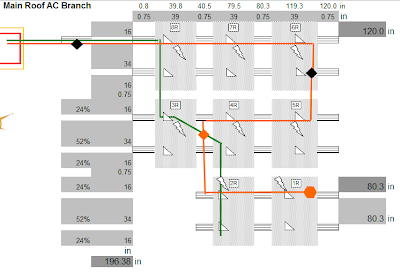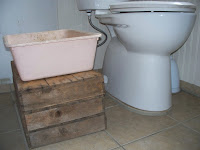In the midst of all the global concern about and
emphasis on decreasing our dependence on non-renewable resources involving
everything from materials we choose to purchase and sources of energy
generation we choose to advocate through to the foods we choose to buy/eat and
modes of transportation we choose to take, we have lost sight of a very
important non-renewable resource ...
TIME
I intentional repeat "we choose"
to draw attention to the fact that the choice has been left up to us and that
often choosing wisely in support of non-dependence on non-renewables and
seeking a sustainable way of life takes time; it takes time to research the
materials, products, and the service providers/companies. It takes time
to ask the questions that need to be asked. It sometimes actually takes
time to conduct research in support of figuring out how to do the right thing e.g., how do I dispose of
construction waste, empty paint cans, electronic equipment, etc. And, quite often,
"it seems to cost more to
make the 'right' choice".
Why is it that "time is
money" unless it's your time?
How much time are we collectively forced to waste? I list the following as possible time wasters:
o
we can't afford to live in the city wherein the
company has chosen to locate
o
the company insists on standard hours
o
the company hasn't figured out resource
management which would allow for telecommuting
I am convinced that if costs associated with
commuting to work i.e., transportation + time were pushed back onto the
employer through legislation, they would
rather give us a raise than bear the costs.
I am also quite sure that the corporations' salary -structure take
advantage of the fact that we don't live in Toronto. This justifies paying us less based on the living
expense where we live. There was a time
during which my commute time (based on % of work time*salary rate) + the
associated transportation costs actually amounted to almost 10% of my salary.
o
in traffic, due to poorly planned infrastructure
and economic development initiatives
o
in doctors' offices – can't offer a logical
reason for this one
o
in line at stores who are experimenting with
self-checkout systems
o
sorting the unnecessary packaging, we never
wanted to begin with, into the right bins
o
figuring out how to dispose of things the system
won't accept
o
I can't even imagine how many hours worth of
valuable human resources are wasted seeking jobs during this era of key word
resume scanning, social media overload, and job scarcity.
o
Worse yet, I wonder how many people are 'under employed' just to pay the bills. Surely, we can devise a better system than this? Waste of human capital should be seen as a bigger problem than waste of $'s.
o
Financial: co-op banks vs. public, mortgage companies
vs. brokers, insurance, personal banking, investment / savings, taxes, pension
plans, etc.
o
Public Services: public vs. private utilities
and their services for electricity, gas, water, landline, cell phone, PDA, internet,
TV.
o
Political: it seems as though every few months
we are being asked to care about yet again another municipal bi-election,
mayoral race, provincial or federal election.
In the grand scheme of things, I've never found the out outcome of any
of these events to really make that much of a difference to my life. While the time I think I should spend
investigating individuals & party platforms is enormous.
All we really need is financial security, light,
climate control (heating/cooling), electricity for our gadgets (AC & DC), and
access to communication, interaction, and entertainment (voice communication,
internet, messaging/emails, and movies).
If I were to approach you and say, "I will take care of all of this
for you and monitor your habits to fine tune the service accordingly", I
think that you would say, "Great".
The daily pestering from the myriad of individual service providers is
just too much.
In support of a sustainable future, I suggest
that much of this should really be offered as a service vs. a commodity. As a commodity, think about $/min, $/GB, $/kWh,
$/m3, etc. there is no incentive on the part of the provider to encourage you
to become more efficient, no incentive for providers of products or ancillary
services to improve, unless mandated (as it currently is through the Ministry
of Energy for electrical appliances in terms of kWh consumption). If we were to talk "lighting
service", with all costs going back to the service provider, I bet you
would quickly see motion detection based lighting with dimmer capabilities, LEDs,
solar tubes, and houses designed to take advantage of natural lighting, etc.
being mandated through the building codes and electrical standards. But, I digress ...
Where any of us find TIME for family, hobbies
& interests, and/or community involvement on top of our jobs and/or studies
completely astounds me.
I really encourage us all to collectively /
individually start pushing back on many of these fronts.
TIME is our PERSONAL non-renewable resource!
Why are we allowing others to mine it
in so many unscrupulous and wasteful ways?
Take Your Stand
Demand the ability to telecommute at least 1 day a week. You wouldn't believe how great you'll feel
and how much more productive you'll probably be. Or discuss shifting your hours so that you
are commuting outside of the "hwy parking hour" window. Even consider, if appropriate, offering to set
up a branch office. Expect/demand more
from your employer. At this day and age
all companies are saying, "Our strength is our people." Well, PEOPLE, speak up to improve your work
environment; too many hours are spent there to ignore. I recently read that OPower has days during
which employees can bring their dogs to work!
How cool is that!
Choose to buy products with less packaging; comment, as appropriate, about
packaging when it seems unavoidable.
Mention to those that make you wait that you're time costs X$/hr i.e.
doctors, suggest to store managers that we need jobs and that auto-tellers are
making the situation worse and wasting your time, etc.
I would advocate contacting your local MP, but it really depends on so many
things. It's up to you on this one.
Stop buying in to the telemarketers offering you better rates for pretty
much any utility/service; they are all about the same in the long run unless
$20/mn is going to bankrupt you in the short term. Request more inclusive, simpler bundlings. Request services i.e., lighting vs. kWh of
electron delivery :) Where there is a demand there will eventually be a service
provider! Maybe it will even be you
& your company that head down this path.
I will happily be your first customer!
I propose that we try to
live in a locally-focused, sustainable, supportive manner
with our neighbours, neighbourhood businesses, and local farmers (markets). Self-sufficiency at a community level is the
key. If we have all we need in terms of social
engagement, food, clothing and shelter and the services required to sustain and
maintain these amenities within our own community, we are invincible!!
If you are overwhelmed by the call for activism, focus on your community or
city and the aspects of it you would like to improve.
Focus on sustainable, local community
/ regional self-sufficiency
To engage with likeminded people in
your area check out the local/global Transition Movement to support the efforts
underway in your community.
It's YOUR TIME!
Don't let anyone
else mine it. Use it wisely!


















